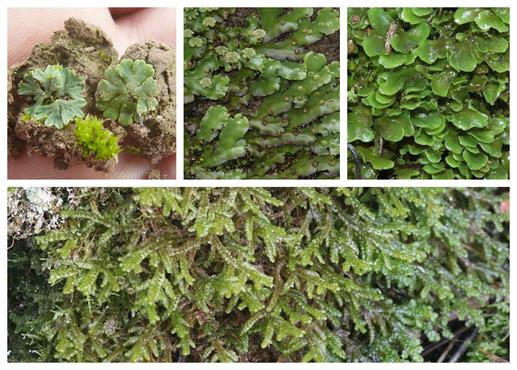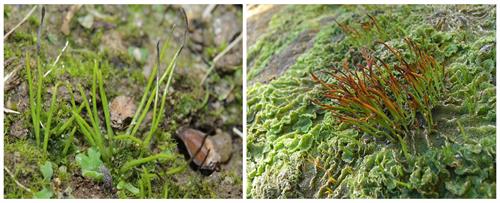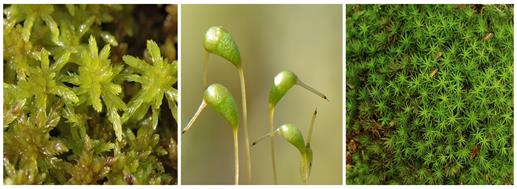PDF chapter test TRY NOW
Classification of bryophytes:
Bryophytes are classified into three classes as follows:
- Hepaticae (Liverworts)
- Anthoceratae (Hornworts)
- Musci (Mosses)
1. Hepaticae (Liverworts):
- These are the lower form of bryophytes as they are simpler in structures than mosses.
- They are the plants closely related to the ancestor that moved to land, and, hence terrestrial habitat.
- Sporophyte is very simple and short-lived.
Example:

Clockwise from top left: Riccia, Marchantia, Pellia and Porella.
2. Anthoceratae (Hornworts):
- These are plants that have colonised various habitats on land, although they are never far from a source of moisture.
- The gametophyte of these plants have an undifferentiated thallus, their rhizoids are unicellular and unbranched.
- Protonemal stage (the first stage that directly develops from the spore) is absent.
- The sporophyte is differentiated into foot and capsule only.
Example:

Antheroceros and Notothylas
3. Musci (Mosses):
- These are the bryophytes that live in a variety of environments.
- These are higher forms of bryophytes in which the gametophytes are differentiated into stems, leaf and root-like parts.
- Protonemal stage is present.
- Sporophytes are differentiated into foot, seta, and capsule.
Example:

Sphagnum, Funaria and Polytrichum
Economic importance of Mosses
1. Environmental uses:
- They prevent soil erosion by reducing the impact of falling rain.
- They help in recycling the nutrients.
- They act as a rock builder.
2. Peat formation:
Peat which is a valuable fuel like coal. It is obtained from Sphagnum (Hence, known as Peat Moss)
3. In seedbeds and nursery:
Sphagnum has the capability of high water absorption. Hence, it is used by the gardeners in nursery, in seedbeds and in greenhouses.
4. As food:
Some of the mosses serve as food materials for herbaceous mammals, birds and other mammals.
Reference:
https://commons.wikimedia.org/wiki/File:Riccia_sorocarpa_Riccia_glauca_050910.jpg
https://www.flickr.com/photos/copepodo/3443571009
https://commons.wikimedia.org/wiki/File:Pellia_endiviifolia_(b,_144739-474749)_2818.jpg
https://commons.wikimedia.org/wiki/File:Porella_platyphylla_(a,_144707-474823)_9042.jpg
https://commons.wikimedia.org/wiki/File:Hornwort_(3144429129).jpg
https://upload.wikimedia.org/wikipedia/commons/a/aa/Anthoceros_agrestis_%28b%2C_150911-484827%29_6288.JPG
https://upload.wikimedia.org/wikipedia/commons/a/aa/Anthoceros_agrestis_%28b%2C_150911-484827%29_6288.JPG
https://en.wikipedia.org/wiki/Sphagnum#/media/File:Sphagnum.flexuosum.jpg
https://www.flickr.com/photos/tabtannery/8539495977
https://commons.wikimedia.org/wiki/File:Polytrichum_formosum_in_nature_reserve_Skocicky_hrad_in_spring_2013_(2).JPG
